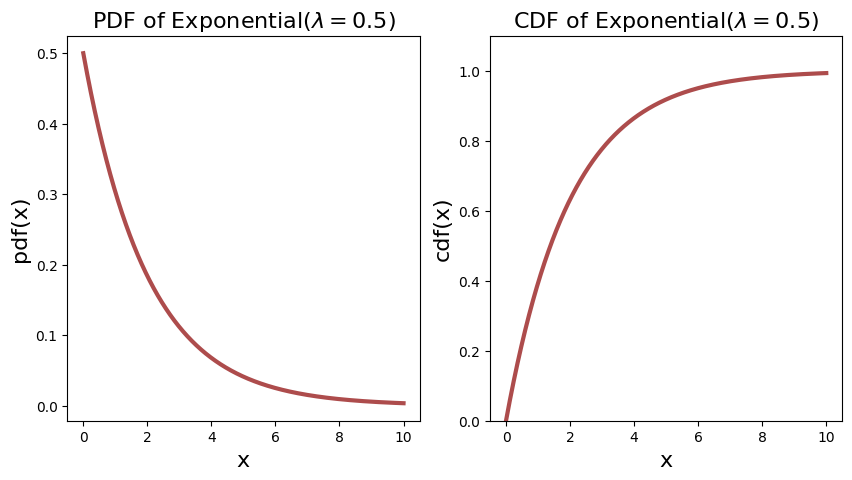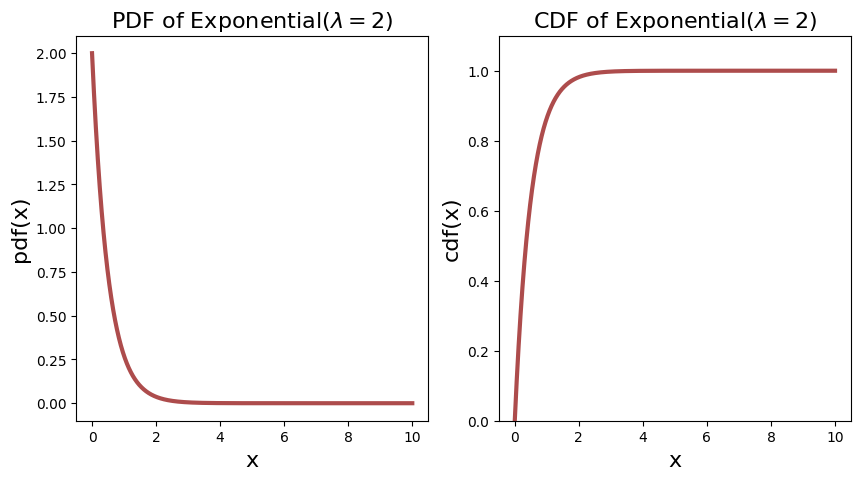Exponential Distribution#
Definition#
Definition 117 (Exponential Distribution (PDF))
\(X\) is a continuous random variable with an exponential distribution if the probability density function is given by:
where \(\lambda > 0\) is the rate parameter (rate of decay).
Some conventions:
We write \(X \sim \exponential(\lambda)\) to indicate that \(X\) has an exponential distribution with rate parameter \(\lambda\).
Remark 46 (Exponential Distribution (PDF))
When \(\lambda = 0\), we have,
This means that \(\pdf(0)\) will be more than 1 if \(\lambda > 0\) [Chan, 2021].
Definition 118 (Exponential Distribution (CDF))
If \(X\) is a continuous random variable with an exponential distribution with rate parameter \(\lambda\), then the CDF is given by integrating the PDF defined in Definition 117:
The PDF and CDF of two exponential distributions are shown below.
<>:19: SyntaxWarning: invalid escape sequence '\l'
<>:20: SyntaxWarning: invalid escape sequence '\l'
<>:19: SyntaxWarning: invalid escape sequence '\l'
<>:20: SyntaxWarning: invalid escape sequence '\l'
/tmp/ipykernel_3735/2726575731.py:19: SyntaxWarning: invalid escape sequence '\l'
plot_continuous_pdf_and_cdf(X1, 0, 10, title="Exponential$(\lambda = 0.5)$")
/tmp/ipykernel_3735/2726575731.py:20: SyntaxWarning: invalid escape sequence '\l'
plot_continuous_pdf_and_cdf(X2, 0, 10, title="Exponential$(\lambda = 2)$")


Expectation and Variance#
Theorem 29 (Expectation and Variance of Exponential Distribution)
If \(X\) is a continuous random variable with an exponential distribution with rate parameter \(\lambda\), then the expectation and variance are given by:
References and Further Readings#
Further readings is a must since Professor Chan give many intuition on how Exponential distribution is used in real life. He also showed how Exponential distribution is derived from the Poisson distribution.
Chan, Stanley H. “Chapter 4.5. Uniform and Exponential Random Variables.” In Introduction to Probability for Data Science, 205-211. Ann Arbor, Michigan: Michigan Publishing Services, 2021.
Pishro-Nik, Hossein. “Chapter 4.2.2. Exponential Distribution” In Introduction to Probability, Statistics, and Random Processes, 249-252. Kappa Research, 2014.

